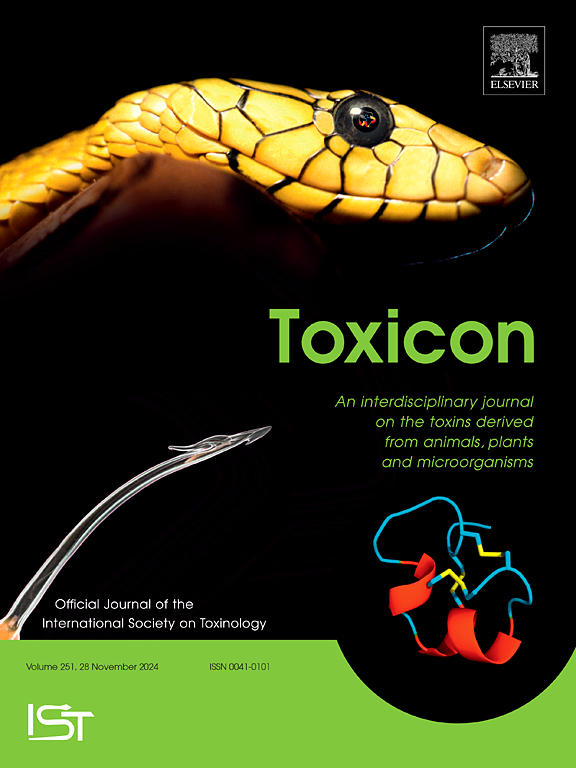重组松香毒素κ-SrXIA的Kv1钾通道阻滞及核磁共振结构
IF 2.6
4区 医学
Q2 PHARMACOLOGY & PHARMACY
引用次数: 0
摘要
圆锥蛇毒的生物活性成分主要是具有二硫键结构的小肽。一些贝壳毒素含有翻译后修饰,作为一种进化策略,以提高它们对离子通道和受体的效力和选择性。很少有已知的concontoxins靶向哺乳动物的Kv1通道。来自圆锥蛇毒液的κ-SrXIA通过精氨酸基环抑制电压门控钾Kv1.2和Kv1.6通道。32个氨基酸的κ-SrXIA具有8个Cys残基,其排列模式定义了i超家族,包括四个二硫桥,两个γ -羧基谷氨酸(Gla)和一个前修饰的c端(X)。在本研究中,我们获得并测定了不含Gla和x的重组蛋白κ-SrXIA的生物活性和核磁共振结构,在大肠杆菌CD41中表达了concontoxin cDNA,并通过gst亲和层析和RP-HPLC纯化。采用双电极电压钳记录法对表达重组Kv1.1、Kv1.2、Kv1.3、Kv1.4和Kv1.6通道的非洲爪蟾卵母细胞进行药理学分析。除Kv1.3外,κ-Sr-XIA不可逆地阻断Kv1通道,表现出比天然螺毒素更低的亲和力和更慢的抑制动力学。即使当κ-SrXIA与i3超家族的GXIA具有高度的结构相似性时,形成ICK+1基序的二硫连接也显示了来自i1超家族的ι-RXIA的两条反平行β-链。这项研究代表了i2超家族成员的第一个三维核磁共振结构。本文章由计算机程序翻译,如有差异,请以英文原文为准。

Block of Kv1 potassium channels and NMR structure of recombinant conotoxin κ-SrXIA
The biologically active components of Conus venoms are mainly small peptides with disulfide-bonded structures. Some conotoxins contain post-translational modifications as an evolutionary strategy to enhance their potency and selectivity towards ion channels and receptors. Few conotoxins are known to target mammalian Kv1 channels. κ-SrXIA from the venom of Conus spurius inhibits the voltage-gated potassium Kv1.2 and Kv1.6 channels through a basic ring of Arg. The 32 amino acid κ-SrXIA has eight Cys residues arranged in the pattern that defines the I-superfamily with four disulfide bridges, two gamma-carboxy-glutamates (Gla), and a Pro-amidated C-terminus (X). In this study, we obtained and determined the biological activity and NMR structure of recombinant κ-SrXIA without Gla and X. The conotoxin cDNA was expressed in E. coli CD41 and purified by GST-affinity chromatography and RP-HPLC. Pharmacological assays were performed by two-electrode voltage-clamp recordings in Xenopus laevis oocytes expressing recombinant Kv1.1, Kv1.2, Kv1.3, Kv1.4 and Kv1.6 channels. Except for Kv1.3, κ-Sr-XIA irreversibly blocked Kv1 channels displaying a lower affinity and a slower inhibition kinetics than native conotoxin. Even when κ-SrXIA displayed a high structural similarity to GXIA from the I3-superfamily, the resultant disulfide connectivity forming an ICK+1 motif showed two antiparallel β-strands as ι-RXIA from the I1-superfamily. This study represents the first 3D NMR structure for a member of the I2-superfamily.
求助全文
通过发布文献求助,成功后即可免费获取论文全文。
去求助
来源期刊

Toxicon
医学-毒理学
CiteScore
4.80
自引率
10.70%
发文量
358
审稿时长
68 days
期刊介绍:
Toxicon has an open access mirror Toxicon: X, sharing the same aims and scope, editorial team, submission system and rigorous peer review. An introductory offer Toxicon: X - full waiver of the Open Access fee.
Toxicon''s "aims and scope" are to publish:
-articles containing the results of original research on problems related to toxins derived from animals, plants and microorganisms
-papers on novel findings related to the chemical, pharmacological, toxicological, and immunological properties of natural toxins
-molecular biological studies of toxins and other genes from poisonous and venomous organisms that advance understanding of the role or function of toxins
-clinical observations on poisoning and envenoming where a new therapeutic principle has been proposed or a decidedly superior clinical result has been obtained.
-material on the use of toxins as tools in studying biological processes and material on subjects related to venom and antivenom problems.
-articles on the translational application of toxins, for example as drugs and insecticides
-epidemiological studies on envenoming or poisoning, so long as they highlight a previously unrecognised medical problem or provide insight into the prevention or medical treatment of envenoming or poisoning. Retrospective surveys of hospital records, especially those lacking species identification, will not be considered for publication. Properly designed prospective community-based surveys are strongly encouraged.
-articles describing well-known activities of venoms, such as antibacterial, anticancer, and analgesic activities of arachnid venoms, without any attempt to define the mechanism of action or purify the active component, will not be considered for publication in Toxicon.
-review articles on problems related to toxinology.
To encourage the exchange of ideas, sections of the journal may be devoted to Short Communications, Letters to the Editor and activities of the affiliated societies.
 求助内容:
求助内容: 应助结果提醒方式:
应助结果提醒方式:


